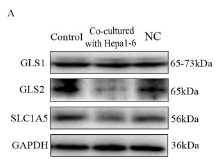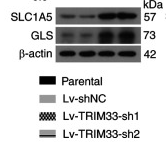| 产品: | SLC1A5 抗体 |
| 货号: | AF6610 |
| 描述: | Rabbit polyclonal antibody to SLC1A5 |
| 应用: | WB |
| 文献验证: | WB |
| 反应: | Human, Mouse, Rat |
| 预测: | Pig, Zebrafish, Bovine, Horse, Sheep, Rabbit, Dog, Xenopus |
| 分子量: | 56 kDa; 57kD(Calculated). |
| 蛋白号: | Q15758 |
| RRID: | AB_2843431 |
产品描述
*The optimal dilutions should be determined by the end user.
*Tips:
WB: 适用于变性蛋白样本的免疫印迹检测. IHC: 适用于组织样本的石蜡(IHC-p)或冰冻(IHC-f)切片样本的免疫组化/荧光检测. IF/ICC: 适用于细胞样本的荧光检测. ELISA(peptide): 适用于抗原肽的ELISA检测.
引用格式: Affinity Biosciences Cat# AF6610, RRID:AB_2843431.
展开/折叠
ASCT2; AAAT; AAAT_HUMAN; ATB(0); ATBO; Baboon M7 virus receptor; FLJ31068; M7V1; M7VS1; Neutral amino acid transporter B(0); R16; RD114/simian type D retrovirus receptor; RDR; RDRC; SLC1A5; Sodium dependent neutral amino acid transporter type 2; Sodium-dependent neutral amino acid transporter type 2; Solute carrier family 1 (neutral amino acid transporter), member 5; Solute carrier family 1 member 5;
抗原和靶标
- Q15758 AAAT_HUMAN:
- Protein BLAST With
- NCBI/
- ExPASy/
- Uniprot
MVADPPRDSKGLAAAEPTANGGLALASIEDQGAAAGGYCGSRDQVRRCLRANLLVLLTVVAVVAGVALGLGVSGAGGALALGPERLSAFVFPGELLLRLLRMIILPLVVCSLIGGAASLDPGALGRLGAWALLFFLVTTLLASALGVGLALALQPGAASAAINASVGAAGSAENAPSKEVLDSFLDLARNIFPSNLVSAAFRSYSTTYEERNITGTRVKVPVGQEVEGMNILGLVVFAIVFGVALRKLGPEGELLIRFFNSFNEATMVLVSWIMWYAPVGIMFLVAGKIVEMEDVGLLFARLGKYILCCLLGHAIHGLLVLPLIYFLFTRKNPYRFLWGIVTPLATAFGTSSSSATLPLMMKCVEENNGVAKHISRFILPIGATVNMDGAALFQCVAAVFIAQLSQQSLDFVKIITILVTATASSVGAAGIPAGGVLTLAIILEAVNLPVDHISLILAVDWLVDRSCTVLNVEGDALGAGLLQNYVDRTESRSTEPELIQVKSELPLDPLPVPTEEGNPLLKHYRGPAGDATVASEKESVM
种属预测
score>80的预测可信度较高,可尝试用于WB检测。*预测模型主要基于免疫原序列比对,结果仅作参考,不作为质保凭据。
High(score>80) Medium(80>score>50) Low(score<50) No confidence
研究背景
Sodium-dependent amino acids transporter that has a broad substrate specificity, with a preference for zwitterionic amino acids. It accepts as substrates all neutral amino acids, including glutamine, asparagine, and branched-chain and aromatic amino acids, and excludes methylated, anionic, and cationic amino acids. Through binding of the fusogenic protein syncytin-1/ERVW-1 may mediate trophoblasts syncytialization, the spontaneous fusion of their plasma membranes, an essential process in placental development.
(Microbial infection) Acts as a cell surface receptor for Feline endogenous virus RD114.
(Microbial infection) Acts as a cell surface receptor for Baboon M7 endogenous virus.
(Microbial infection) Acts as a cell surface receptor for type D simian retroviruses.
Cell membrane>Multi-pass membrane protein. Melanosome.
Note: Identified by mass spectrometry in melanosome fractions from stage I to stage IV.
Placenta, lung, skeletal muscle, kidney, pancreas, and intestine.
Homotrimer (Probable). Interacts with ERVH48-1/suppressyn; may negatively regulate syncytialization.
Belongs to the dicarboxylate/amino acid:cation symporter (DAACS) (TC 2.A.23) family. SLC1A5 subfamily.
研究领域
· Human Diseases > Cancers: Overview > Central carbon metabolism in cancer. (View pathway)
· Organismal Systems > Digestive system > Protein digestion and absorption.
文献引用
Application: WB Species: Human Sample: EC cell
Application: WB Species: Human Sample: CCAs
Application: WB Species: Mouse Sample: cytotoxic T lymphocytes (CTLs) and hepatoma cells
限制条款
产品的规格、报价、验证数据请以官网为准,官网链接:www.affbiotech.com | www.affbiotech.cn(简体中文)| www.affbiotech.jp(日本語)产品的数据信息为Affinity所有,未经授权不得收集Affinity官网数据或资料用于商业用途,对抄袭产品数据的行为我们将保留诉诸法律的权利。
产品相关数据会因产品批次、产品检测情况随时调整,如您已订购该产品,请以订购时随货说明书为准,否则请以官网内容为准,官网内容有改动时恕不另行通知。
Affinity保证所销售产品均经过严格质量检测。如您购买的商品在规定时间内出现问题需要售后时,请您在Affinity官方渠道提交售后申请。产品仅供科学研究使用。不用于诊断和治疗。
产品未经授权不得转售。
Affinity Biosciences将不会对在使用我们的产品时可能发生的专利侵权或其他侵权行为负责。Affinity Biosciences, Affinity Biosciences标志和所有其他商标所有权归Affinity Biosciences LTD.



